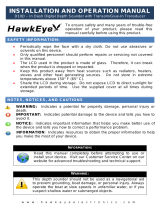
EQUIPMENT LISTS
iv
Cable Assy. 02S4147-1 000-141-082 For speed/temp. and temp.
sensors
MJ Cable Assy. MJ-A6SPF0016-005C 000-159-689-10 For FAX-30
External Buzzer OP03-136 000-086-443-00 Buzzer: PKB5-3A40
Network (LAN) Cable MOD-Z072-020+ 001-167-880-10 LAN cable, cross-pair, 2 m
MOD-Z073-030+ 000-167-171-10
LAN cable, straight, 2 pairs,
3 m
MOD-Z072-050+ 001-167-890-10 LAN cable, cross-pair, 5 m
MOD-Z072-100+ 001-167-900-10 LAN cable, cross-pair, 10 m
CAN bus Connector SS-050505-FMF-TS001 000-168-603-10 Micro style: 3
NC-050505-FMF-TS001 000-160-807-10 Mini style: 2, micro style: 1
LTWMC-05BMMT-
SL8001
000-168-604-10
Micro style, male, termina-
tion resistor
LTWMN-05AMMT-
SL8001
000-160-508-10
Mini style, male, termination
resistor
LTWMC-05BFFT-
SL8001
000-168-605-10
Micro style, female,
termination resistor
LTWMN-05AFFT-
SL8001
000-160-509-10
Mini style, female,
termination resistor
FRU-0505-FF-IS 001-077-830-10 w/in-line terminator
Transducer 520-5PSD (*) 000-015-204-00
520-5MSD (*) 000-015-212-00
525-5PWD (*) 000-146-966-00
520-PLD (*) 000-023-680-00
525T-BSD (*) 000-023-020-00
525T-PWD (*) 000-023-019-00
SS60-SLTD/12 (*) 000-023-676-00
SS60-SLTD/20 (*) 000-023-677-00
525T-LTD/12 (*) 000-023-679-00
525T-LTD/20 (*) 000-023-678-00
50/200-1T *10M* (*) 000-015-170-00 Matching box MB-1100
required for installation of
these transducers.
50B-6 *10M* 000-015-042-00
50B-6B *15M* 000-015-043-00
200B-5S *10M* 000-015-029-00
Triducer 526TID-HDD (*) 000-023-021-00
525STID-PWD (*) 000-011-784-00
525STID-MSD (*) 000-011-783-00
Extension Cable** C332 10M 001-464-120 10m, for transducer
Speed/Temperature
Sensor
ST-02MSB 000-137-986-01 Thru-hull type, metal
ST-02PSB 000-137-987-01 Thru-hull type, plastic
Temperature Sensor T-04MSB 000-026-893 Thru-hull type
T-04MTB 000-026-894 Transom mount
Bracket 12 OP19-13 001-337-410-00 For TZTL12F
Bracket 15 OP19-14 001-337-420-00 For TZTL15F
Retrofit Kit For VX2
10.4"
OP19-15 001-337-430-00 For TZTL12F
Retrofit Kit For MDF12 OP19-16 001-337-440-00 For TZTL12F
Front Fixing Panel Kit OP19-17 001-337-450-00 For TZTL15F
Name Type Code No. Remarks




















